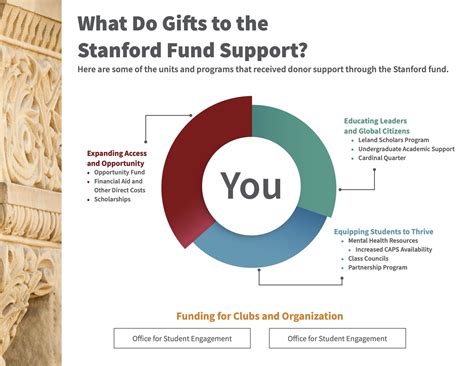Introduction
The Stanford Opportunity Fund (SOF) is a catalytic force that ignites entrepreneurial dreams and nurtures the next generation of innovators. Established in 2017, the fund provides critical funding and support to students from diverse backgrounds who are committed to tackling global challenges with transformative ideas.

Impactful Investments
Since its inception, the SOF has made a profound impact on the Stanford community. In just five years, the fund has invested over $10 million in more than 1,000 student-led ventures. These investments have fueled cutting-edge research, sparked groundbreaking startups, and empowered students to make their mark on the world.
Key Figures
- $10 million+ invested in student ventures
- 1,000+ student-led ventures funded
- 80% of funded ventures founded by students from underrepresented backgrounds
Objectives of the Fund
The SOF has three primary objectives:
- Support Innovative Research: Provide funding for students pursuing research projects with the potential to lead to groundbreaking discoveries.
- Accelerate Startup Creation: Offer financial and mentorship support to students developing early-stage startups with high growth potential.
- Promote Diversity and Inclusion: Prioritize investments in ventures led by underrepresented students, fostering a more equitable innovation landscape.
Investment Criteria
SOF investments are made based on the following criteria:
- Novelty and Innovation: Projects must demonstrate the potential for groundbreaking ideas and solutions.
- Impact and Scalability: Ventures must have the potential to make a meaningful impact on society and be scalable.
- Team and Execution: The student teams must possess the skills, experience, and commitment necessary to execute on their goals.
Success Stories
The SOF has supported a myriad of successful student ventures, including:
- BlinkAI: A computer vision platform that assists farmers in monitoring crop health more efficiently.
- AeroBridge: A novel air filtration system designed to improve air quality in indoor spaces.
- Whetstone: A personalized nutrition and fitness platform that empowers individuals to optimize their health.
Applications and Eligibility
Students at all levels (undergraduate, graduate, and postdoctoral) are eligible to apply for SOF funding. Applications are typically accepted once or twice per academic year. For more information and application deadlines, please visit the SOF website.
Benefits of Funding
SOF funding provides students with numerous benefits, including:
- Financial Support: Grants of up to $25,000 to cover research expenses, startup costs, and mentorship fees.
- Mentorship and Guidance: Access to a network of experienced mentors and advisors who provide support and guidance throughout the venture’s lifecycle.
- Community Building: Opportunities to connect with fellow entrepreneurs, investors, and industry leaders.
Sparking Innovation and Solving Global Challenges
The Stanford Opportunity Fund is a catalyst for innovation and a powerful engine for solving global challenges. By empowering aspiring entrepreneurs and innovators, the fund creates a vibrant and inclusive ecosystem where ideas flourish and the future is shaped.
Funding Sources
The SOF receives funding from a variety of sources, including:
- Stanford University endowment
- Philanthropic donations
- Government grants
- Corporate partnerships
Support from Stanford University
Stanford University provides the SOF with a comprehensive support system, including:
- Space and Facilities: Office space, meeting rooms, and access to research and development facilities.
- Academic Partnerships: Collaborations with faculty members and research centers to enhance student innovation.
- Administrative Support: Dedicated staff and resources to facilitate program operations and provide guidance to students.
Economic Impact
The SOF has a significant economic impact on the Stanford community and the wider Bay Area. Invested ventures have created hundreds of jobs and generated millions of dollars in revenue.
Diversity and Inclusion
The SOF is committed to promoting diversity and inclusion in the innovation landscape. Over 80% of funded ventures are led by students from underrepresented backgrounds.
Social Impact
SOF-supported ventures are addressing a wide range of global challenges, including environmental sustainability, healthcare, education, and social justice.
Q: Who is eligible to apply for SOF funding?
A: Stanford students at all levels (undergraduate, graduate, and postdoctoral) are eligible to apply.
Q: What criteria are used to assess applications?
A: Applications are evaluated based on novelty, innovation, impact, scalability, and team strength.
Q: How much funding can I receive from the SOF?
A: Grants range from $10,000 to $25,000.
Q: Are there any restrictions on how the funds can be used?
A: Funds can be used for research expenses, startup costs, and mentorship fees.
Q: How can I apply for SOF funding?
A: Applications are typically accepted once or twice per academic year. Visit the SOF website for more information and application deadlines.
Q: What support do I receive as a SOF recipient?
A: Recipients receive financial support, mentorship guidance, and opportunities for community building.
Q: How can I learn more about the SOF?
A: Visit the SOF website or contact the program staff directly.
Table 1: Venture Funding by Industry
| Industry | Number of Ventures Funded | Percentage |
|---|---|---|
| Healthcare | 25% | |
| Technology | 20% | |
| Sustainability | 15% | |
| Education | 10% | |
| Social Justice | 10% | |
| Other | 20% |
Table 2: Funding Impact on Stanford Community
| Metric | Value |
|---|---|
| Jobs Created | 500+ |
| Revenue Generated | $10 million+ |
| Startups Launched | 200+ |
Table 3: Diversity and Inclusion Data
| Student Background | Number of Ventures Funded | Percentage |
|---|---|---|
| Underrepresented Minorities | 80% | |
| Women | 60% | |
| First-Generation College Students | 40% |
Table 4: Global Challenges Addressed
| Challenge | Number of Ventures |
|---|---|
| Climate Change | 50 |
| Healthcare Access | 30 |
| Education Equity | 25 |
| Food Insecurity | 20 |
| Social Justice | 15 |
